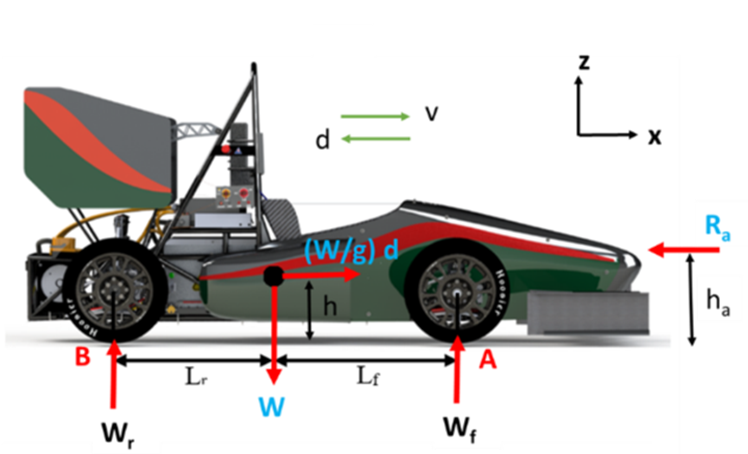Main Article Content
Abstract
This research aimed to reduce the mass of a racing car upright made from Aluminum Alloy 7075-T6 through topology optimization and fatigue life analysis. The design process included stages of meeting over-design conditions, optimizing mass reduction for the uprights, and smoothing critical areas. Finite element simulation was used throughout to analyze strength and fatigue life, considering loading conditions, geometry, and material properties. Special attention was given to critical areas to ensure optimized stress distribution and minimize stress concentration. The results showed that extreme loading conditions occur during braking while turning. The optimization process followed boundary conditions and design requirements, resulting in a 56% mass reduction from 944.39 grams to 416.43 grams while maintaining structural integrity. The optimized design featured a larger fillet radius, reducing stress concentration in critical areas and lowering the maximum stress value. The final design demonstrated a smoother structure with reduced stress concentrations, confirming the effectiveness of the optimization.
Keywords
Article Details

This work is licensed under a Creative Commons Attribution-NonCommercial 4.0 International License.
References
- S. Rosenthal, F. Maaß, M. Kamaliev, M. Hahn, S. Gies, and A. E. Tekkaya, “Lightweight in Automotive Components by Forming Technology,” Automotive Innovation, vol. 3, no. 3, pp. 195–209, Sep. 2020, doi: 10.1007/s42154-020-00103-3.
- K. Kawajiri, M. Kobayashi, and K. Sakamoto, “Lightweight materials equal lightweight greenhouse gas emissions?: A historical analysis of greenhouse gases of vehicle material substitution,” Journal of Cleaner Production, vol. 253, p. 119805, Apr. 2020, doi: 10.1016/j.jclepro.2019.119805.
- W. Zhang and J. Xu, “Advanced lightweight materials for Automobiles: A review,” Materials & Design, vol. 221, p. 110994, Sep. 2022, doi: 10.1016/j.matdes.2022.110994.
- A. R. Yıldız, U. A. Kılıçarpa, E. Demirci, and M. Doğan, “Topography and topology optimization of diesel engine components for light-weight design in the automotive industry,” Materials Testing, vol. 61, no. 1, pp. 27–34, Jan. 2019, doi: 10.3139/120.111277.
- S. De Pinto et al., “On the Comparison of 2- and 4-Wheel-Drive Electric Vehicle Layouts with Central Motors and Single- and 2-Speed Transmission Systems,” Energies, vol. 13, no. 13, p. 3328, Jun. 2020, doi: 10.3390/en13133328.
- A. Garg, “Fatigue Analysis and Optimization of Upright of a FSAE Vehicle,” International Journal of Science and Research (IJSR), vol. 6, no. 9, 2017, doi: 10.21275/ART20176999.
- Shobhit Agarwal and Tarun Saatyaki, “Fatigue Analysis for Upright of a FSAE Vehicle,” International Journal of Engineering Research and, vol. V9, no. 03, Mar. 2020, doi: 10.17577/IJERTV9IS030392.
- O. Babannavar and A. M. Deshpande, “Design, analysis, and optimization of an FSAE upright,” IOP Conference Series: Materials Science and Engineering, vol. 1166, no. 1, p. 012043, Jul. 2021, doi: 10.1088/1757-899X/1166/1/012043.
- R. L. Jhala, K. D. Kothari, and S. S. Khandare, “Component Fatigue Behaviors and Life Predictions of A Steering Knuckle using Finite Element Analysis,” in Imecs 2009: International Multi-Conference of Engineers and Computer Scientists, Vols I and II, 2009.
- K. J. Kim, “Light-weight design and fatigue characteristics of automotive knuckle by using finite element analysis,” Journal of Mechanical Science and Technology, vol. 35, no. 7, pp. 2989–2995, Jul. 2021, doi: 10.1007/s12206-021-0622-0.
- P. Griškevičius and A. Žiliukas, “The crash energy absorption of the vehicles front structures,” TRANSPORT, vol. 18, no. 2, pp. 97–101, Apr. 2003, doi: 10.3846/16483840.2003.10414073.
- C. Riordan, A. Tovar, and J. Renaud, “Topology Optimization of a Formula SAE Upright Using OptiStruct,” in SAE Technical Paper, Apr. 2010. doi: 10.4271/2010-01-0396.
- W. Mansor, W. Muhammad, E. Sujatmika, Hamid, and F. Tarlochan, “Design Improvement of Steering Knuckle Component Using Shape Optimization,” International Journal of Advanced Computer Science, vol. 6, pp. 65–69, 2012.
- M. I. N. Ma’arof, V. Ratanakvisal, L. J. Wei, A. R. Ghani, and G. T. Chala, “Design and Analysis of the Suspension Upright Structure of a Formula SAE Car,” in International Conference on Innovation and Technopreneurship, 2019.
- M. Hunar, L. Jancar, D. Krzikalla, D. Kaprinay, and D. Srnicek, “Comprehensive View on Racing Car Upright Design and Manufacturing,” Symmetry, vol. 12, no. 6, p. 1020, Jun. 2020, doi: 10.3390/sym12061020.
- S. D’Imperio, T. M. Berruti, C. Gastaldi, and P. Soccio, “Practical Design Guidelines for Topology Optimization of Flexible Mechanisms: A Comparison between Weakly Coupled Methods,” Robotics, vol. 13, no. 4, p. 55, Mar. 2024, doi: 10.3390/robotics13040055.
- A. Zuska, D. Kurczyński, and J. T. Jackowski, “Study of Loads Acting on the Load during the Sudden Braking of a Vehicle,” Applied Sciences, vol. 13, no. 3, p. 1559, Jan. 2023, doi: 10.3390/app13031559.
- Z. Chen, K. Long, P. Wen, and S. Nouman, “Fatigue-resistance topology optimization of continuum structure by penalizing the cumulative fatigue damage,” Advances in Engineering Software, vol. 150, p. 102924, Dec. 2020, doi: 10.1016/j.advengsoft.2020.102924.
- S. H. Jeong, D.-H. Choi, and G. H. Yoon, “Fatigue and static failure considerations using a topology optimization method,” Applied Mathematical Modelling, vol. 39, no. 3–4, pp. 1137–1162, Feb. 2015, doi: 10.1016/j.apm.2014.07.020.

